2014 MERCEDES-BENZ GL tow
[x] Cancel search: towPage 22 of 462
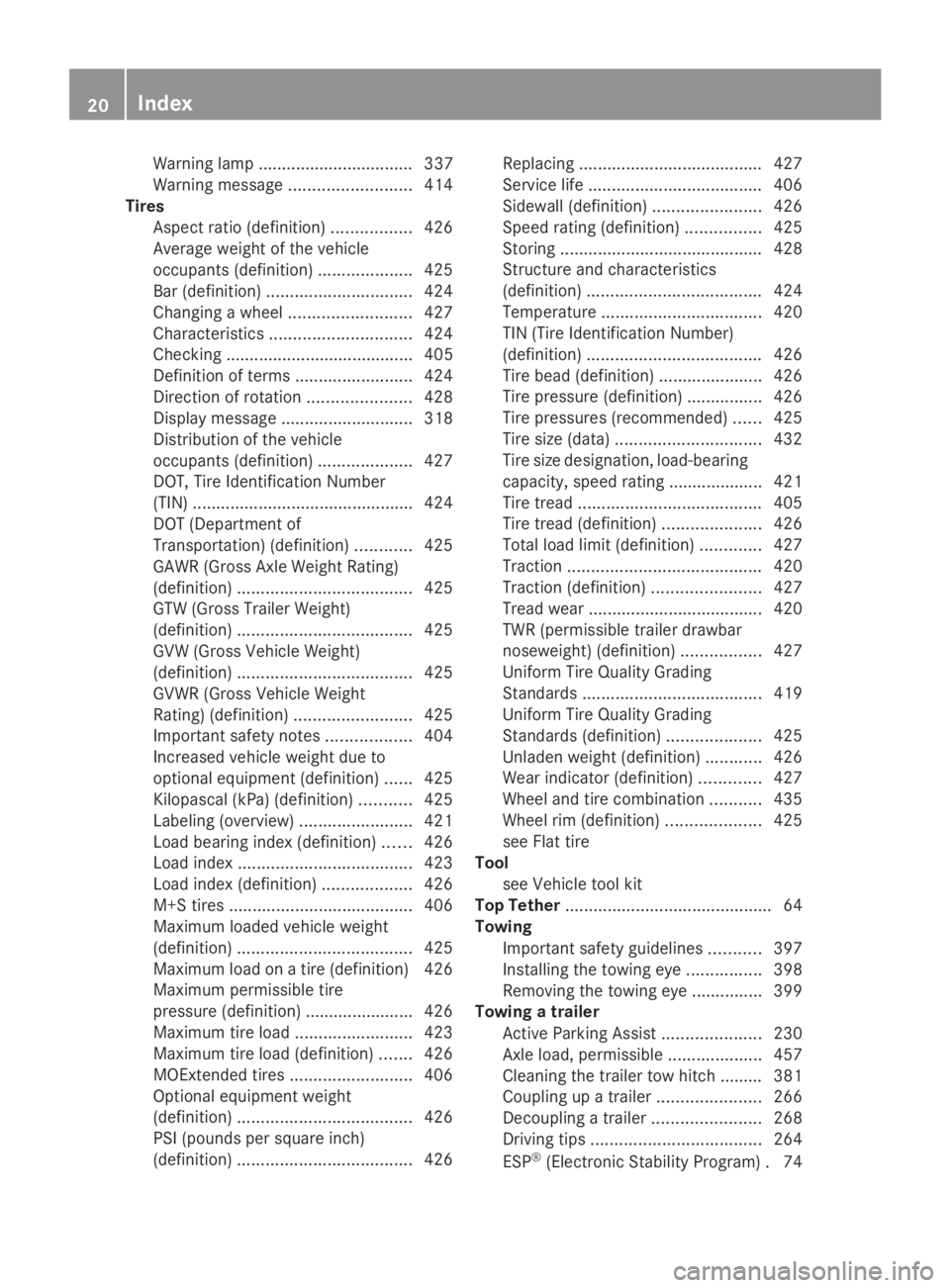
Warning lamp ................................. 337
Warning message..........................414
Tires
Aspect ratio (definition).................426
Average weight of the vehicle
occupants (definition)....................425
Bar (definition)...............................424
Changing a wheel..........................427
Characteristics..............................424
Checking ........................................ 405
Definition of terms.........................424
Direction of rotation......................428
Display message............................318
Distribution of the vehicle
occupants (definition)....................427
DOT, Tire Identification Number
(TIN) ...............................................424
DOT (Department of
Transportation) (definition)............425
GAWR (Gross Axle Weight Rating)
(definition).....................................425
GTW (Gross Trailer Weight)
(definition).....................................425
GVW (Gross Vehicle Weight)
(definition).....................................425
GVWR (Gross Vehicle Weight
Rating) (definition).........................425
Important safety notes..................404
Increased vehicle weight due to
optional equipment (definition)......425
Kilopascal (kPa) (definition)...........425
Labeling (overview)........................421
Load bearing index (definition)......426
Load index.....................................423
Load index (definition)...................426
M+S tires.......................................406
Maximum loaded vehicle weight
(definition).....................................425
Maximum load on a tire (definition) 426
Maximum permissible tire
pressure (definition) ....................... 426
Maximum tire load.........................423
Maximum tire load (definition).......426
MOExtended tires..........................406
Optional equipment weight
(definition).....................................426
PSI (pounds per square inch)
(definition).....................................426
Replacing.......................................427
Service life.....................................406
Sidewall (definition).......................426
Speed rating (definition)................425
Storing...........................................428
Structure and characteristics
(definition).....................................424
Temperature..................................420
TIN (Tire Identification Number)
(definition).....................................426
Tire bead (definition)......................426
Tire pressure (definition)................426
Tire pressures (recommended)......425
Tire size (data)...............................432
Tire size designation, load-bearing
capacity, speed rating .................... 421
Tire tread.......................................405
Tire tread (definition).....................426
Total load limit (definition).............427
Traction.........................................420
Traction (definition).......................427
Tread wear.....................................420
TWR (permissible trailer drawbar
noseweight) (definition).................427
Uniform Tire Quality Grading
Standards......................................419
Uniform Tire Quality Grading
Standards (definition)....................425
Unladen weight (definition)............426
Wear indicator (definition).............427
Wheel and tire combination...........435
Wheel rim (definition)....................425
see Flat tire
Tool
see Vehicle tool kit
Top Tether............................................64
Towing
Important safety guidelines...........397
Installing the towing eye................398
Removing the towing eye...............399
Towing a trailer
Active Parking Assist.....................230
Axle load, permissible....................457
Cleaning the trailer tow hitch ......... 381
Coupling up a trailer......................266
Decoupling a trailer.......................268
Driving tips....................................264
ESP®(Electronic Stability Program).74
20Index
Page 23 of 462
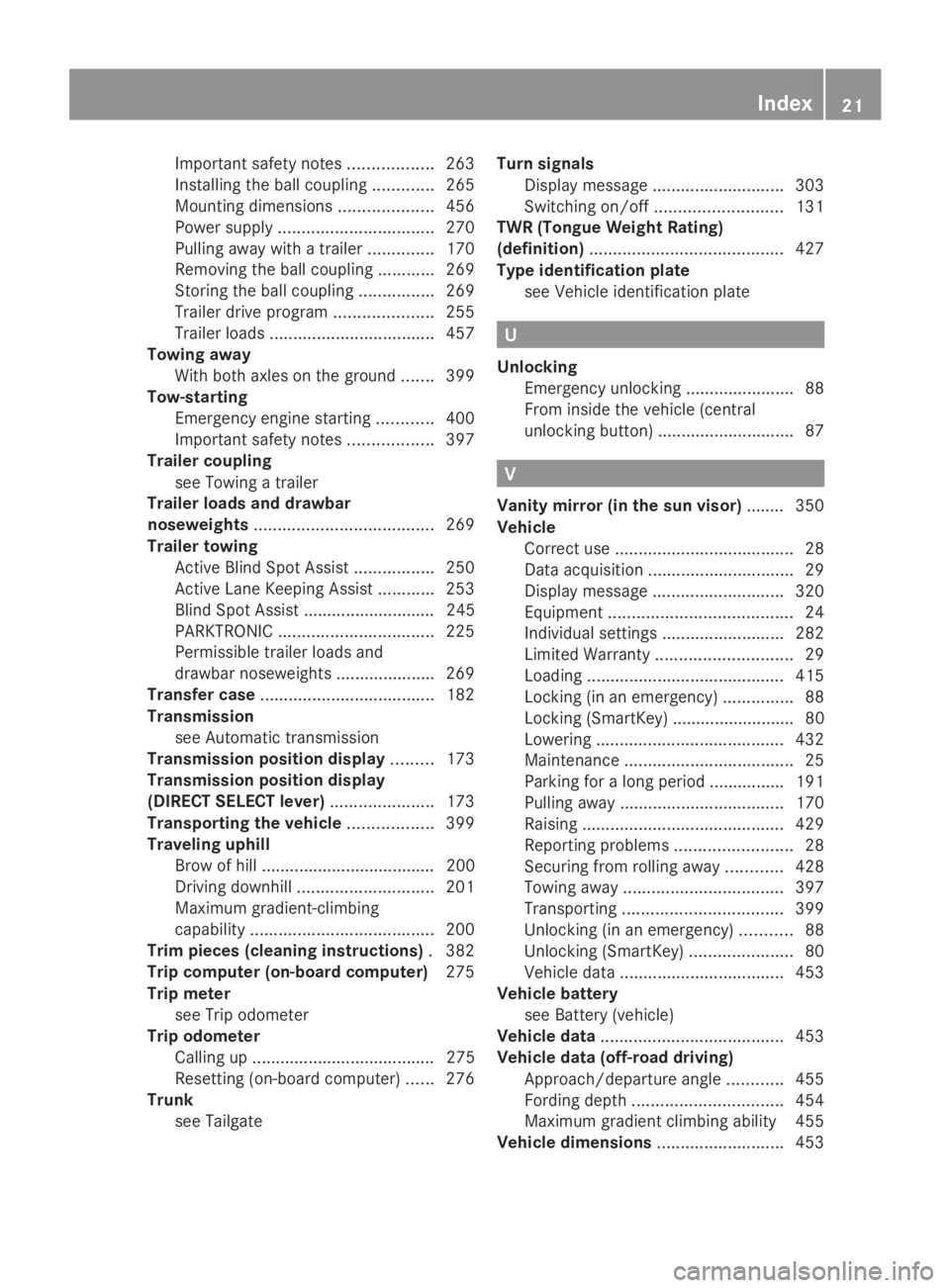
Important safety notes..................263
Installing the ball coupling.............265
Mounting dimensions....................456
Power supply.................................270
Pulling away with a trailer..............170
Removing the ball coupling............269
Storing the ball coupling................269
Trailer drive program.....................255
Trailer loads...................................457
Towing away
With both axles on the ground.......399
Tow-starting
Emergency engine starting............400
Important safety notes..................397
Trailer coupling
see Towing a trailer
Trailer loads and drawbar
noseweights......................................269
Trailer towing
Active Blind Spot Assist.................250
Active Lane Keeping Assist............253
Blind Spot Assist ............................ 245
PARKTRONIC.................................225
Permissible trailer loads and
drawbar noseweights.....................269
Transfer case.....................................182
Transmission
see Automatic transmission
Transmission position display.........173
Transmission position display
(DIRECT SELECT lever)......................173
Transporting the vehicle..................399
Traveling uphill
Brow of hill ..................................... 200
Driving downhill.............................201
Maximum gradient-climbing
capability.......................................200
Trim pieces (cleaning instructions).382
Trip computer (on-board computer)275
Trip meter
see Trip odometer
Trip odometer
Calling up ....................................... 275
Resetting (on-board computer)......276
Trunk
see Tailgate
Turn signals
Display message............................303
Switching on/off...........................131
TWR (Tongue Weight Rating)
(definition).........................................427
Type identification plate
see Vehicle identification plate
U
Unlocking
Emergency unlocking.......................88
From inside the vehicle (central
unlocking button).............................87
V
Vanity mirror (in the sun visor)........350
Vehicle
Correct use......................................28
Data acquisition...............................29
Display message............................320
Equipment.......................................24
Individual settings..........................282
Limited Warranty.............................29
Loading..........................................415
Locking (in an emergency)...............88
Locking (SmartKey) .......................... 80
Lowering........................................432
Maintenance....................................25
Parking for a long period ................ 191
Pulling away...................................170
Raising...........................................429
Reporting problems.........................28
Securing from rolling away............428
Towing away..................................397
Transporting..................................399
Unlocking (in an emergency)...........88
Unlocking (SmartKey)......................80
Vehicle data...................................453
Vehicle battery
see Battery (vehicle)
Vehicle data.......................................453
Vehicle data (off-road driving)
Approach/departure angle............455
Fording depth................................454
Maximum gradient climbing ability 455
Vehicle dimensions...........................453
Index21
Page 30 of 462
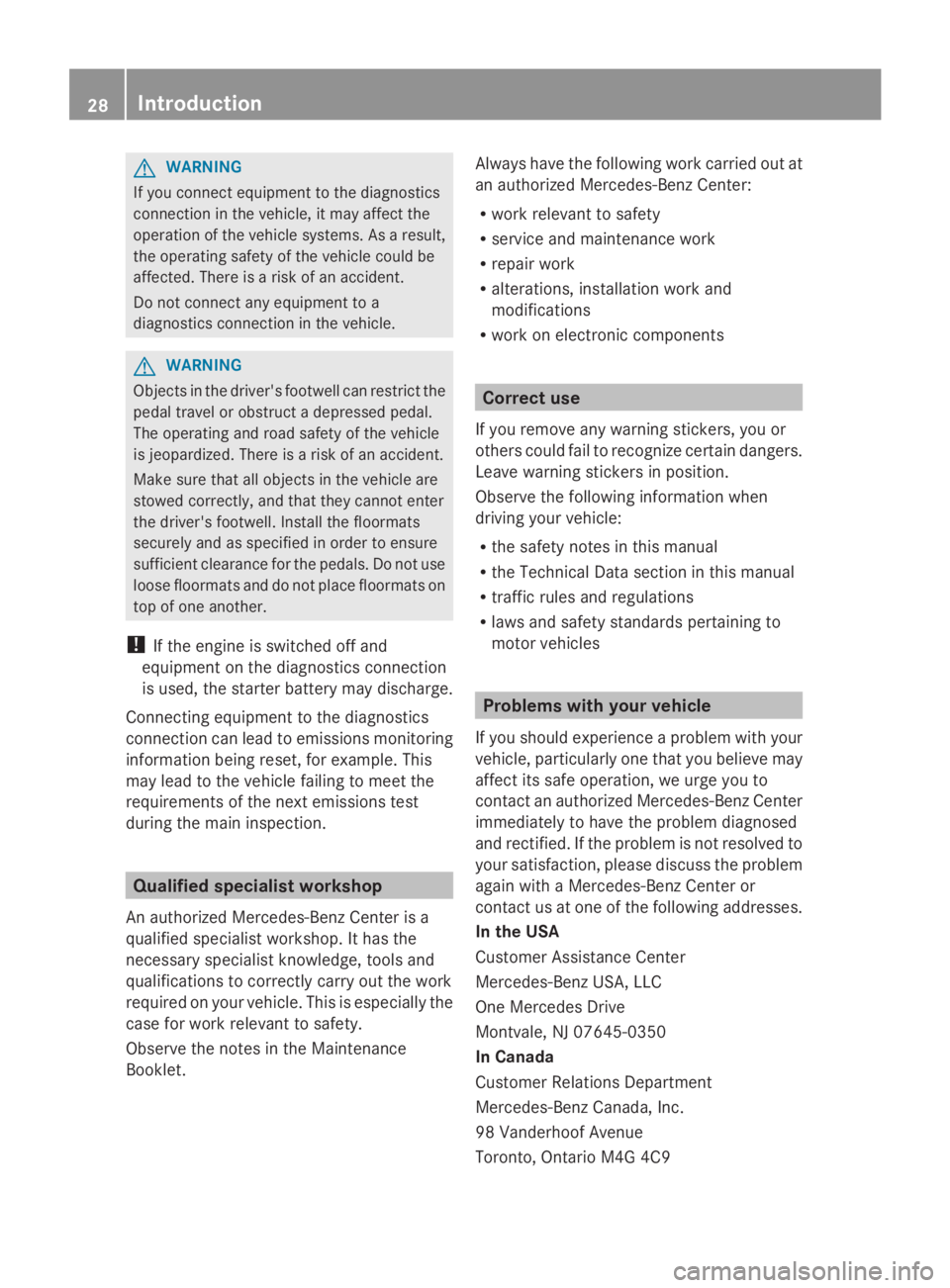
GWARNING
If you connect equipment to the diagnostics
connection in the vehicle, it may affect the
operation of the vehicle systems. As a result,
the operating safety of the vehicle could be
affected. There is a risk of an accident.
Do not connect any equipment to a
diagnostics connection in the vehicle.
GWARNING
Objects in the driver's footwell can restrict the
pedal travel or obstruct a depressed pedal.
The operating and road safety of the vehicle
is jeopardized. There is a risk of an accident.
Make sure that all objects in the vehicle are
stowed correctly, and that they cannot enter
the driver's footwell. Install the floormats
securely and as specified in order to ensure
sufficient clearance for the pedals. Do not use
loose floormats and do not place floormats on
top of one another.
!If the engine is switched off and
equipment on the diagnostics connection
is used, the starter battery may discharge.
Connecting equipment to the diagnostics
connection can lead to emissions monitoring
information being reset, for example. This
may lead to the vehicle failing to meet the
requirements of the next emissions test
during the main inspection.
Qualified specialist workshop
An authorized Mercedes-Benz Center is a
qualified specialist workshop. It has the
necessary specialist knowledge, tools and
qualifications to correctly carry out the work
required on your vehicle. This is especially the
case for work relevant to safety.
Observe the notes in the Maintenance
Booklet.
Always have the following work carried out at
an authorized Mercedes-Benz Center:
Rwork relevant to safety
Rservice and maintenance work
Rrepair work
Ralterations, installation work and
modifications
Rwork on electronic components
Correct use
If you remove any warning stickers, you or
others could fail to recognize certain dangers.
Leave warning stickers in position.
Observe the following information when
driving your vehicle:
Rthe safety notes in this manual
Rthe Technical Data section in this manual
Rtraffic rules and regulations
Rlaws and safety standards pertaining to
motor vehicles
Problems with your vehicle
If you should experience a problem with your
vehicle, particularly one that you believe may
affect its safe operation, we urge you to
contact an authorized Mercedes-Benz Center
immediately to have the problem diagnosed
and rectified. If the problem is not resolved to
your satisfaction, please discuss the problem
again with a Mercedes-Benz Center or
contact us at one of the following addresses.
In the USA
Customer Assistance Center
Mercedes-Benz USA, LLC
One Mercedes Drive
Montvale, NJ 07645-0350
In Canada
Customer Relations Department
Mercedes-Benz Canada, Inc.
98 Vanderhoof Avenue
Toronto, Ontario M4G 4C9
28Introduction
Page 48 of 462
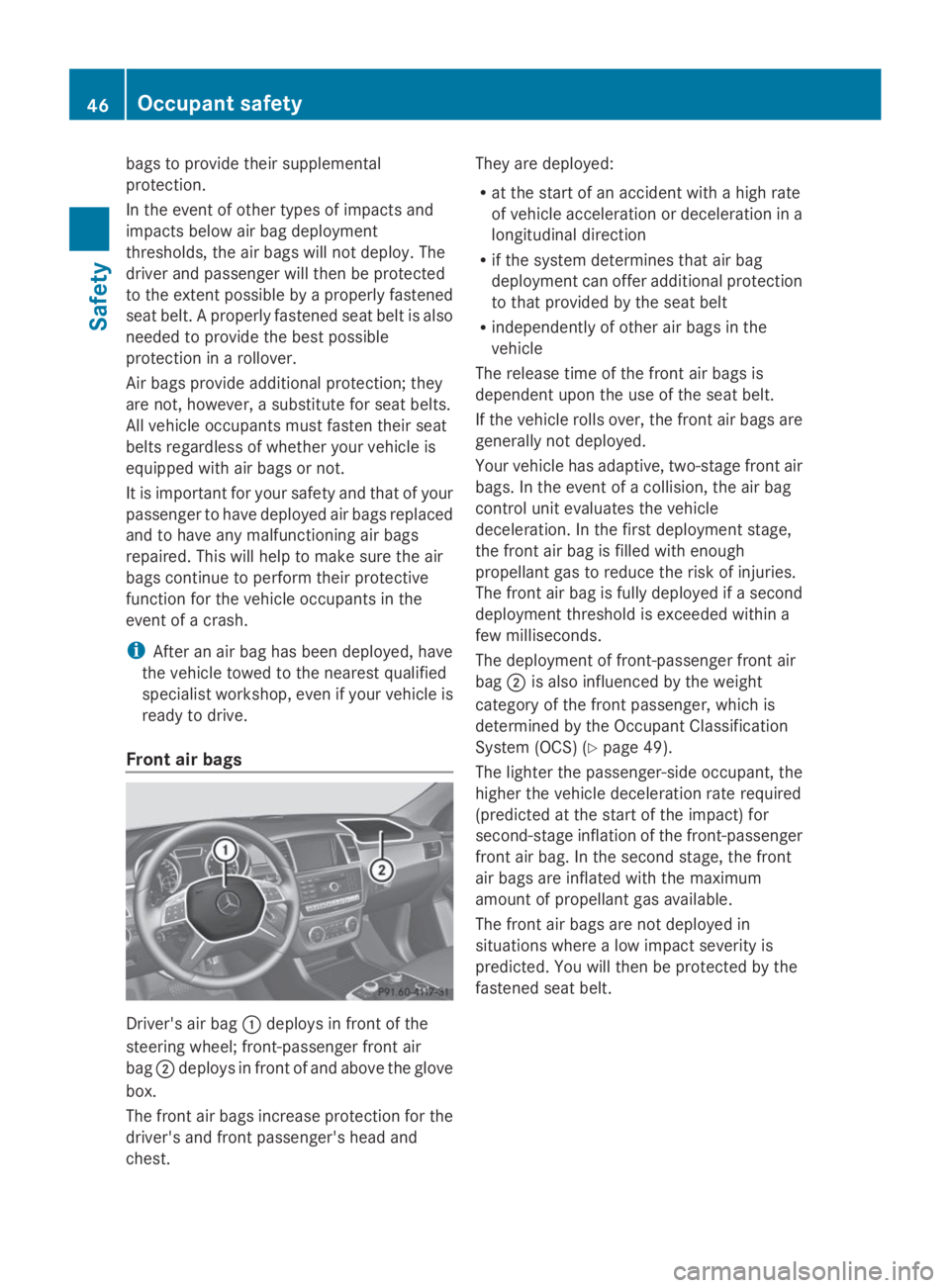
bags to provide their supplemental
protection.
In the event of other types of impacts and
impacts below air bag deployment
thresholds, the air bags will not deploy. The
driver and passenger will then be protected
to the extent possible by a properly fastened
seat belt. A properly fastened seat belt is also
needed to provide the best possible
protection in a rollover.
Air bags provide additional protection; they
are not, however, a substitute for seat belts.
All vehicle occupants must fasten their seat
belts regardless of whether your vehicle is
equipped with air bags or not.
It is important for your safety and that of your
passenger to have deployed air bags replaced
and to have any malfunctioning air bags
repaired. This will help to make sure the air
bags continue to perform their protective
function for the vehicle occupants in the
event of a crash.
iAfter an air bag has been deployed, have
the vehicle towed to the nearest qualified
specialist workshop, even if your vehicle is
ready to drive.
Front air bags
Driver's air bag�Cdeploys in front of the
steering wheel; front-passenger front air
bag�Ddeploys in front of and above the glove
box.
The front air bags increase protection for the
driver's and front passenger's head and
chest.
They are deployed:
Rat the start of an accident with a high rate
of vehicle acceleration or deceleration in a
longitudinal direction
Rif the system determines that air bag
deployment can offer additional protection
to that provided by the seat belt
Rindependently of other air bags in the
vehicle
The release time of the front air bags is
dependent upon the use of the seat belt.
If the vehicle rolls over, the front air bags are
generally not deployed.
Your vehicle has adaptive, two-stage front air
bags. In the event of a collision, the air bag
control unit evaluates the vehicle
deceleration. In the first deployment stage,
the front air bag is filled with enough
propellant gas to reduce the risk of injuries.
The front air bag is fully deployed if a second
deployment threshold is exceeded within a
few milliseconds.
The deployment of front-passenger front air
bag�Dis also influenced by the weight
category of the front passenger, which is
determined by the Occupant Classification
System (OCS) (Ypage 49).
The lighter the passenger-side occupant, the
higher the vehicle deceleration rate required
(predicted at the start of the impact) for
second-stage inflation of the front-passenger
front air bag. In the second stage, the front
air bags are inflated with the maximum
amount of propellant gas available.
The front air bags are not deployed in
situations where a low impact severity is
predicted. You will then be protected by the
fastened seat belt.
46Occupant safety
Safety
Page 61 of 462
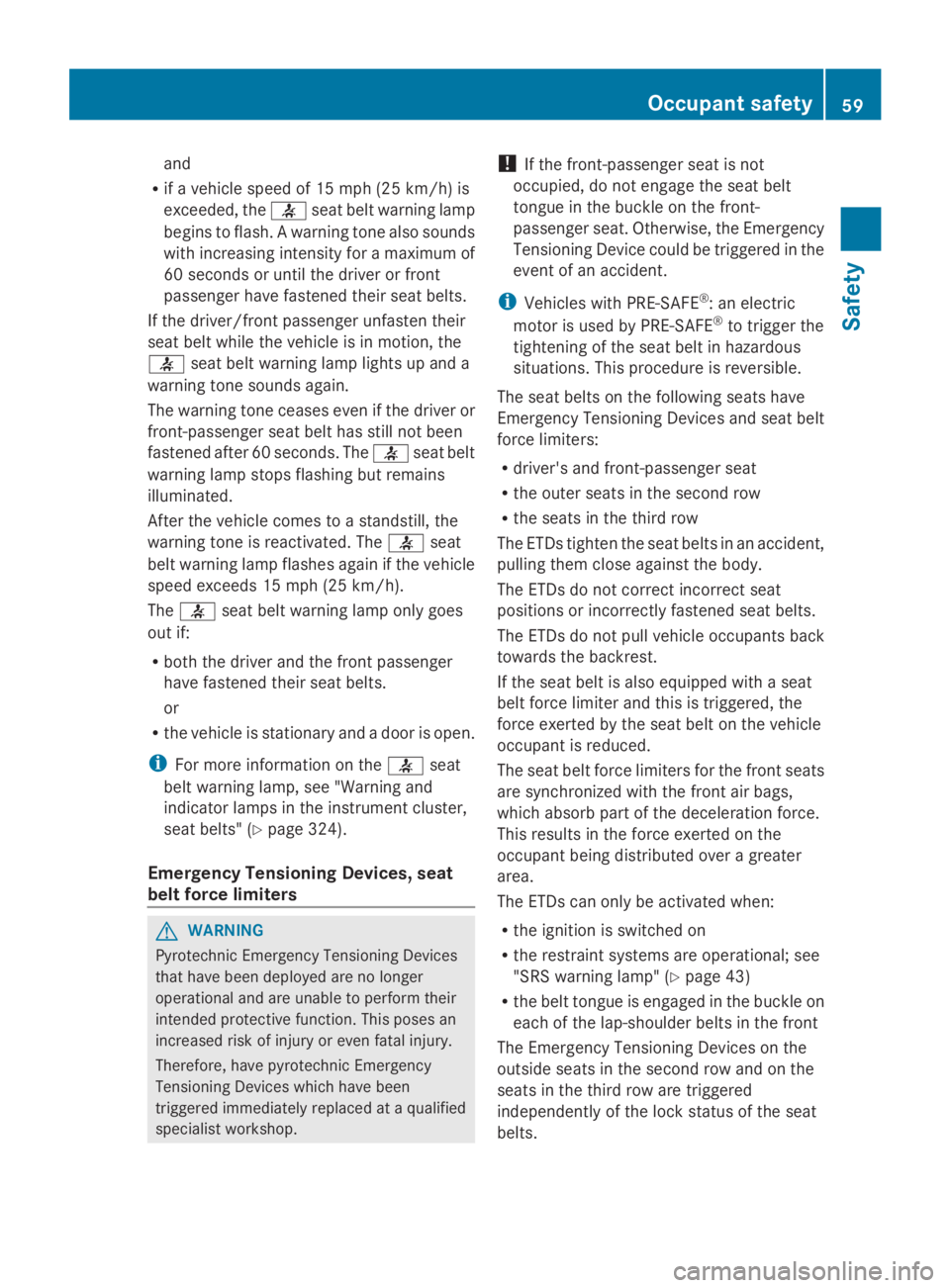
and
Rif a vehicle speed of 15 mph (25 km/h) is
exceeded, the�vseat belt warning lamp
begins to flash. A warning tone also sounds
with increasing intensity for a maximum of
60 seconds or until the driver or front
passenger have fastened their seat belts.
If the driver/front passenger unfasten their
seat belt while the vehicle is in motion, the
�vseat belt warning lamp lights up and a
warning tone sounds again.
The warning tone ceases even if the driver or
front-passenger seat belt has still not been
fastened after 60 seconds. The�vseat belt
warning lamp stops flashing but remains
illuminated.
After the vehicle comes to a standstill, the
warning tone is reactivated. The�vseat
belt warning lamp flashes again if the vehicle
speed exceeds 15 mph (25 km/h).
The�vseat belt warning lamp only goes
out if:
Rboth the driver and the front passenger
have fastened their seat belts.
or
Rthe vehicle is stationary and a door is open.
iFor more information on the�vseat
belt warning lamp, see "Warning and
indicator lamps in the instrument cluster,
seat belts" (Ypage 324).
Emergency Tensioning Devices, seat
belt force limiters
GWARNING
Pyrotechnic Emergency Tensioning Devices
that have been deployed are no longer
operational and are unable to perform their
intended protective function. This poses an
increased risk of injury or even fatal injury.
Therefore, have pyrotechnic Emergency
Tensioning Devices which have been
triggered immediately replaced at a qualified
specialist workshop.
!If the front-passenger seat is not
occupied, do not engage the seat belt
tongue in the buckle on the front-
passenger seat. Otherwise, the Emergency
Tensioning Device could be triggered in the
event of an accident.
iVehicles with PRE-SAFE®: an electric
motor is used by PRE-SAFE®to trigger the
tightening of the seat belt in hazardous
situations. This procedure is reversible.
The seat belts on the following seats have
Emergency Tensioning Devices and seat belt
force limiters:
Rdriver's and front-passenger seat
Rthe outer seats in the second row
Rthe seats in the third row
The ETDs tighten the seat belts in an accident,
pulling them close against the body.
The ETDs do not correct incorrect seat
positions or incorrectly fastened seat belts.
The ETDs do not pull vehicle occupants back
towards the backrest.
If the seat belt is also equipped with a seat
belt force limiter and this is triggered, the
force exerted by the seat belt on the vehicle
occupant is reduced.
The seat belt force limiters for the front seats
are synchronized with the front air bags,
which absorb part of the deceleration force.
This results in the force exerted on the
occupant being distributed over a greater
area.
The ETDs can only be activated when:
Rthe ignition is switched on
Rthe restraint systems are operational; see
"SRS warning lamp" (Ypage 43)
Rthe belt tongue is engaged in the buckle on
each of the lap-shoulder belts in the front
The Emergency Tensioning Devices on the
outside seats in the second row and on the
seats in the third row are triggered
independently of the lock status of the seat
belts.
Occupant safety59
Safety
Z
Page 90 of 462
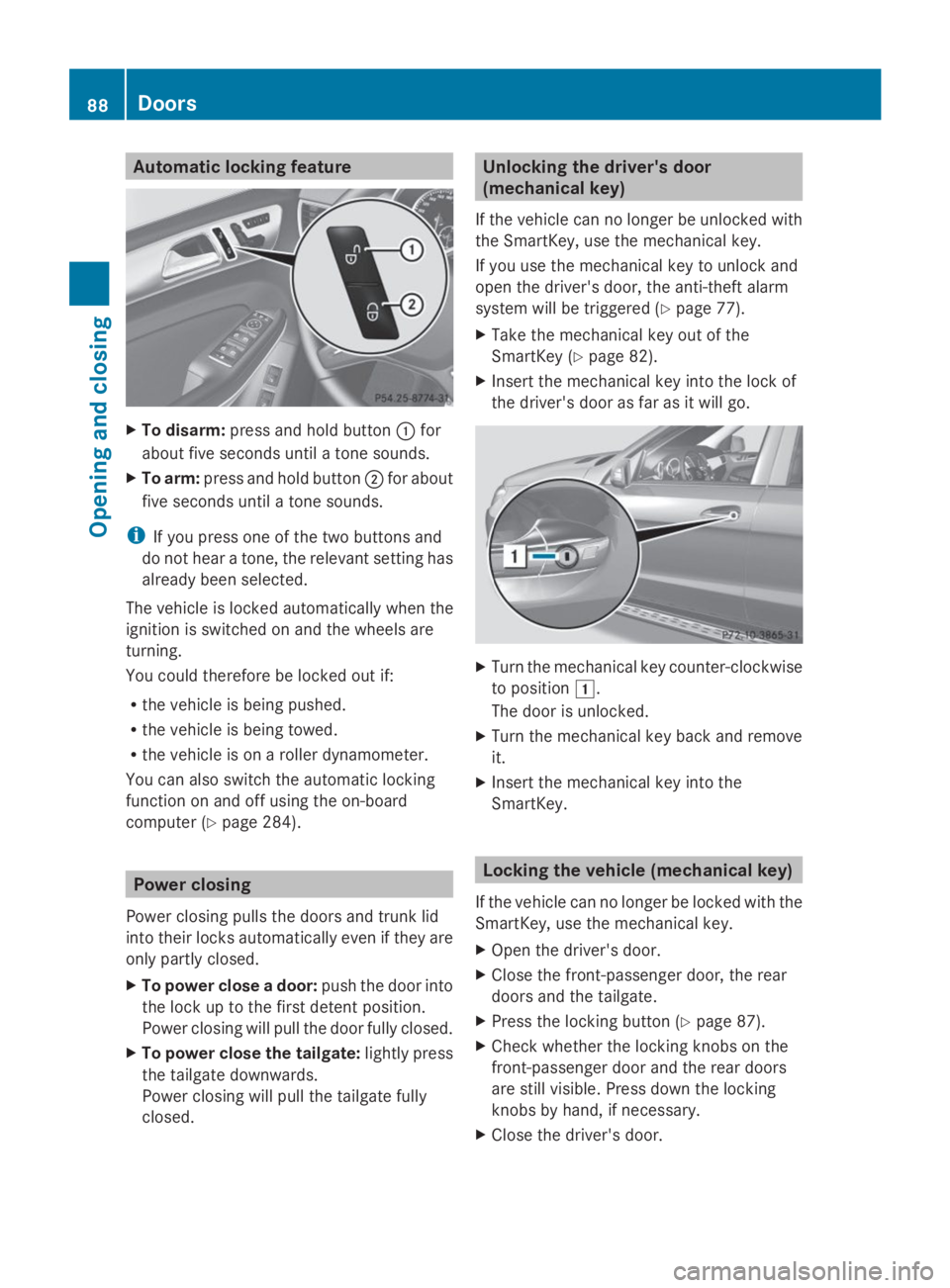
Automatic locking feature
XTo disarm:press and hold button�Cfor
about five seconds until a tone sounds.
XTo arm:press and hold button�Dfor about
five seconds until a tone sounds.
iIf you press one of the two buttons and
do not hear a tone, the relevant setting has
already been selected.
The vehicle is locked automatically when the
ignition is switched on and the wheels are
turning.
You could therefore be locked out if:
Rthe vehicle is being pushed.
Rthe vehicle is being towed.
Rthe vehicle is on a roller dynamometer.
You can also switch the automatic locking
function on and off using the on-board
computer (Ypage 284).
Power closing
Power closing pulls the doors and trunk lid
into their locks automatically even if they are
only partly closed.
XTo power close a door:push the door into
the lock up to the first detent position.
Power closing will pull the door fully closed.
XTo power close the tailgate:lightly press
the tailgate downwards.
Power closing will pull the tailgate fully
closed.
Unlocking the driver's door
(mechanical key)
If the vehicle can no longer be unlocked with
the SmartKey, use the mechanical key.
If you use the mechanical key to unlock and
open the driver's door, the anti-theft alarm
system will be triggered (Ypage 77).
XTake the mechanical key out of the
SmartKey (Ypage 82).
XInsert the mechanical key into the lock of
the driver's door as far as it will go.
XTurn the mechanical key counter-clockwise
to position�G.
The door is unlocked.
XTurn the mechanical key back and remove
it.
XInsert the mechanical key into the
SmartKey.
Locking the vehicle (mechanical key)
If the vehicle can no longer be locked with the
SmartKey, use the mechanical key.
XOpen the driver's door.
XClose the front-passenger door, the rear
doors and the tailgate.
XPress the locking button (Ypage 87).
XCheck whether the locking knobs on the
front-passenger door and the rear doors
are still visible. Press down the locking
knobs by hand, if necessary.
XClose the driver's door.
88Doors
Opening and closing
Page 167 of 462
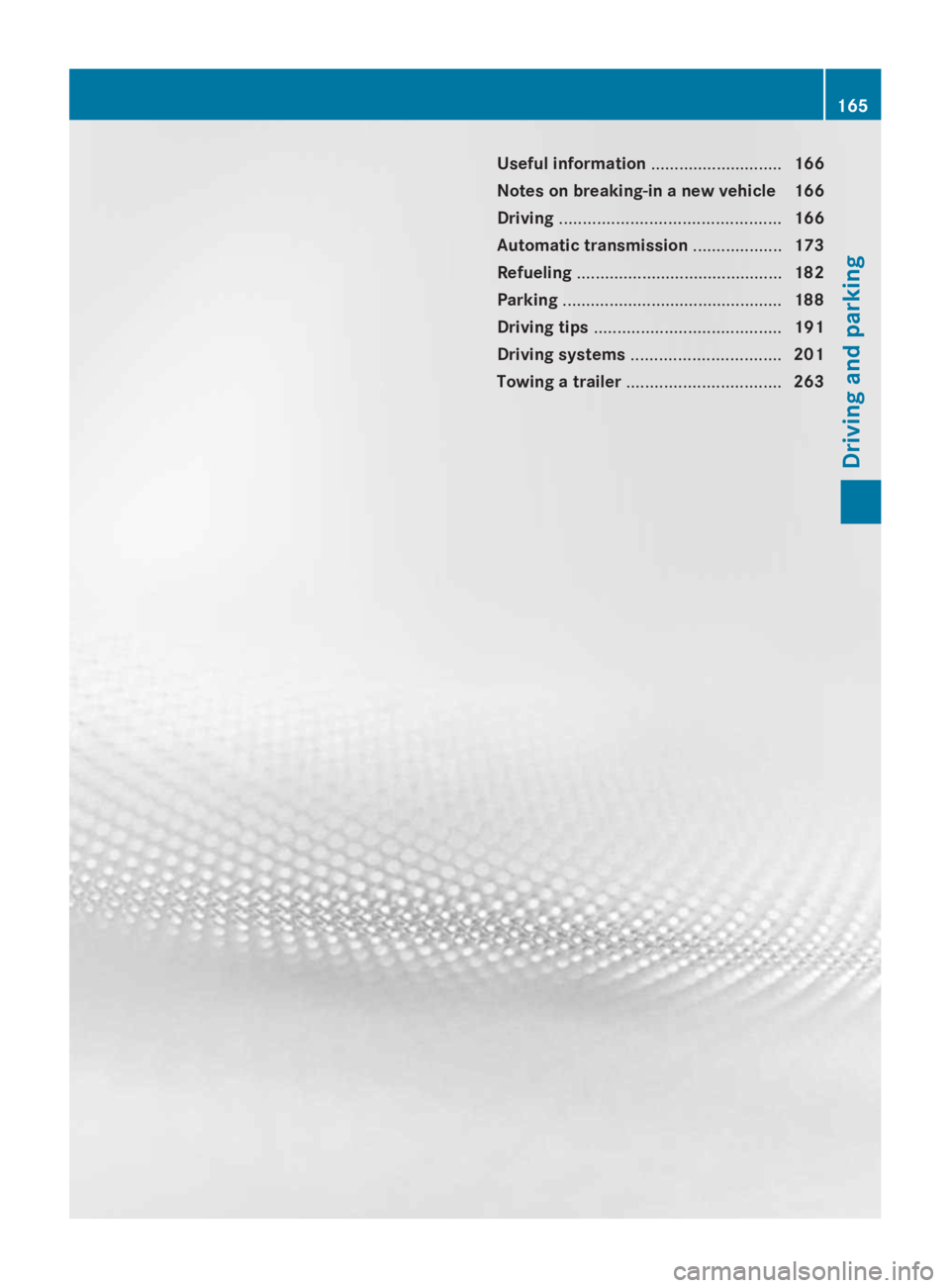
Useful information............................166
Notes on breaking-in a new vehicle 166
Driving...............................................166
Automatic transmission...................173
Refueling............................................182
Parking...............................................188
Driving tips........................................191
Driving systems................................201
Towing a trailer.................................263
165
Driving and parking
Page 176 of 462
![MERCEDES-BENZ GL 2014 Owners Manual �]Park position with parking lock
�^Reverse gear
�\\Neutral
�[Drive
XPush the DIRECT SELECT lever in the
direction of arrowP.
iThe automatic transmission shifts into
park positionPautomatically:
Rif y MERCEDES-BENZ GL 2014 Owners Manual �]Park position with parking lock
�^Reverse gear
�\\Neutral
�[Drive
XPush the DIRECT SELECT lever in the
direction of arrowP.
iThe automatic transmission shifts into
park positionPautomatically:
Rif y](/manual-img/4/59076/w960_59076-175.png)
�]Park position with parking lock
�^Reverse gear
�\\Neutral
�[Drive
XPush the DIRECT SELECT lever in the
direction of arrowP.
iThe automatic transmission shifts into
park positionPautomatically:
Rif you open the driver's door while the
vehicle is stationary in transmission
positionDorR
Rif you open the door while traveling at
very low speeds in transmission position
DorR
Engaging park position P automatically
Park positionPis automatically engaged if:
Ryou switch off the engine using the
SmartKey and remove the SmartKey.
Ryou switch off the engine using the Start/
Stop button and open one of the front
doors.
Rthe HOLD (Ypage 216) or DISTRONIC
PLUS (Ypage 203) function brake your
vehicle until it is stationary and at least one
of the following conditions is fulfilled:
-there is a system malfunction.
-the vehicle is on a steep uphill or downhill
gradient. The electric parking brake is
then also applied.
Engaging reverse gear R
!Only shift the automatic transmission to
Rwhen the vehicle is stationary.
XWhen the vehicle is stationary, depress the
brake pedal.
XPush the DIRECT SELECT lever up past the
first point of resistance.
Shifting to neutral N
GWARNING
If children are left unsupervised in the vehicle,
they could:
Ropen the doors, thus endangering other
people or road users.
Rget out and disrupt traffic.
Roperate the vehicle's equipment.
Additionally, children could set the vehicle in
motion if, for example, they:
Rrelease the parking brake.
Rshifting the automatic transmission out of
park positionP
RStart the engine.
There is a risk of an accident and injury.
When leaving the vehicle, always take the
SmartKey with you and lock the vehicle. Never
leave children or animals unattended in the
vehicle. Always keep the SmartKey out of
reach of children.
XWhen the vehicle is stationary, depress the
brake pedal.
XPush the DIRECT SELECT lever up or down
to the first point of resistance.
If the engine has been switched off, the
automatic transmission automatically shifts
toN.
If you want the automatic transmission to
remain in neutralN, e.g. when having the
vehicle cleaned in an automatic car wash with
a towing system, observe the following notes:
174Automatic transmission
Driving and parking